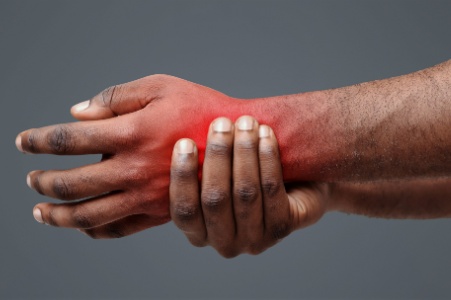Blog
Items filtered by date: July 2025
Carpal Tunnel Syndrome and How Relief Is Found

Carpal tunnel syndrome is a condition where the median nerve is compressed as it travels through the wrist, leading to pain and dysfunction. Common symptoms include tingling, numbness, weakness, and a burning sensation in the hand or fingers, often worsening with repetitive use. Causes may include repetitive hand motions, wrist injuries, inflammation, or underlying conditions such as diabetes. Risk factors involve prolonged computer use, manual labor, pregnancy, and genetic predisposition. A chiropractor can help by addressing joint alignment, reducing nerve irritation, and improving overall wrist function through manual therapy and specific exercises. If you are experiencing wrist discomfort or hand weakness, it is suggested that you consult a chiropractor for a noninvasive approach to relief and prevention.
Carpal Tunnel Syndrome
Carpal tunnel syndrome, or CTS, is a condition caused by compression of the median nerve, which runs through the carpal tunnel in the wrist. This tunnel is a narrow passageway surrounded by bones and ligaments, and when it becomes compressed or inflamed, it can put pressure on the nerve. Symptoms of CTS include tingling, numbness, weakness, and pain in the hand and fingers, often making simple tasks difficult and uncomfortable.
Chiropractic care offers a non-invasive approach to managing CTS by addressing alignment and reducing nerve pressure. Chiropractors start by evaluating the wrist, elbow, and even the cervical spine or neck, as misalignments in these areas can contribute to nerve compression in the wrist. Through gentle adjustments, chiropractors can improve the alignment of the wrist and spine, helping to reduce the pressure on the median nerve.
In addition to adjustments, chiropractors may use soft tissue therapy, such as stretching and myofascial release, to reduce inflammation surrounding the wrist and enhance mobility.
Why Consider Chiropractic for CTS?
Chiropractic care can provide lasting relief by targeting the root causes of CTS, reducing pain, and promoting long-term hand and wrist health.
Can Chiropractic Care Address Repetitive Strain as a Cause of CTS?
Chiropractic care can help manage repetitive strain by improving joint alignment and recommending ergonomic adjustments.
If you have any questions, please feel free to contact our office located in Bellmore, NY .
Definition and Causes of Temporomandibular Joint Disorder

Temporomandibular joint disorder, commonly known as TMJ, affects the joint connecting the jaw to the skull and can lead to pain and limited jaw movement. Causes include teeth grinding, jaw injury, arthritis, or jaw misalignment. Symptoms may involve jaw pain, clicking sounds, headaches, neck stiffness, or difficulty chewing. Risk factors include stress, poor posture, previous trauma, and dental issues. A chiropractor can help by using gentle adjustments to improve jaw alignment, relieve muscle tension, and restore joint function. They may also suggest posture correction and relaxation techniques. If you are experiencing TMJ discomfort or jaw stiffness, it is suggested that you visit a chiropractor to explore safe and natural methods for long-lasting relief and improved quality of life.
TMJ: Temporomandibular Join Disorders
Temporomandibular Joint, or TMJ disorders, affect the hinge connecting the jaw to the skull, leading to pain and difficulty with jaw movement. Common causes include teeth grinding, jaw clenching, injury, or arthritis. Symptoms often include jaw pain, clicking or popping sounds when opening the mouth, headaches, and difficulty chewing. If left untreated, TMJ disorders can significantly impact daily activities, including eating and speaking.
Managing TMJ disorders typically involves lifestyle adjustments, such as stress reduction to minimize clenching and grinding, along with gentle jaw exercises to improve mobility. In some cases, wearing a night guard may help protect the joint from further strain.
Chiropractic care offers a unique approach to TMJ relief by focusing on the alignment of the jaw and neck. Chiropractors use gentle adjustments to reduce tension in the surrounding muscles and improve joint function. Techniques like myofascial release may be applied to alleviate tightness in the face and jaw area. By addressing related spinal or muscular imbalances, chiropractic care helps reduce pain and promote overall jaw health.
1. Can TMJ problems cause dizziness or vertigo?
Yes, TMJ dysfunction can affect the inner ear through muscle tension or nerve involvement, leading to balance issues or dizziness. Chiropractic adjustments to the neck and jaw can address alignment issues that contribute to dizziness.
2. Can chewing on one side worsen TMJ disorders?
Yes, consistently chewing on one side can overwork one side of the jaw, leading to imbalances and further TMJ issues. A chiropractor can restore balance to the jaw and surrounding muscles, reducing the impact of uneven chewing.
For additional information, please contact our office located in Bellmore, NY .
Chiropractic Care and Pinched Nerve Pain

A pinched nerve, also known as radiculopathy, occurs when surrounding tissues apply pressure to a nerve, disrupting its function. This condition can lead to pain, tingling, numbness, or weakness, often radiating from the spine into the arms or legs. Common causes include herniated discs, spinal misalignment, or inflammation. Risk factors include repetitive movements, poor posture, obesity, or underlying conditions like arthritis. A chiropractor can help by identifying the source of compression and using spinal adjustments, stretching techniques, and posture guidance to relieve pressure and restore nerve function. If you are experiencing signs of a pinched nerve, it is suggested that you consult a chiropractor who can offer a safe and noninvasive way to reduce symptoms and support long-term recovery.
Pinched Nerve
A pinched nerve occurs when surrounding tissues, such as bones, muscles, or tendons, apply excessive pressure on a nerve. This condition can cause pain, numbness, tingling, or weakness, often in the neck, back, or limbs. Everyday activities, poor posture, or repetitive motions are common triggers. Left untreated, the condition may worsen, leading to chronic discomfort and reduced mobility.
Chiropractors use a hands-on approach to relieve the pressure that causes a pinched nerve. By performing gentle spinal adjustments, they create space for the nerve to function properly, alleviating discomfort. Chiropractic care may also include stretching exercises to improve flexibility and targeted muscle work to reduce surrounding tension. Patients often receive guidance on posture and activity modifications to prevent recurrence. This tailored approach focuses on restoring normal nerve function and improving overall quality of life.
1. Are pinched nerves only caused by spinal issues?
No, they can also result from tight muscles, inflammation, or repetitive strain. Chiropractors address both spinal and muscular causes.
2. How does a chiropractor determine the location of a pinched nerve?
Chiropractors use physical exams, mobility tests, and sometimes imaging studies like X-rays to pinpoint the source of nerve compression.
For additional information, please contact our office located in Bellmore, NY .
Why More People Are Turning to Salt Therapy

Salt therapy has grown in popularity as people seek natural, low-risk options for improving their health and well-being. This simple practice, which involves breathing in microscopic salt particles, appeals to those looking for ways to ease respiratory discomfort, support skin clarity, or simply unwind in a calming space. Its drug-free nature and gentle delivery make it an appealing choice for both adults and children. One reason for its rise is that most people tolerate salt therapy very well. Some may feel slightly thirsty after a session, but serious reactions are rare. Even so, individuals with complex health concerns or those taking medications should speak with a healthcare provider before beginning any new therapy. As awareness grows, salt therapy continues to gain recognition for its ease, accessibility, and potential benefits. If you are curious about trying this natural wellness method, it is suggested that you visit a chiropractor who offers salt therapy.
Halo therapy, also known as salt therapy, is a natural treatment that involves inhaling microscopic salt particles in a controlled environment, often a salt room or salt cave. This practice is gaining popularity for its potential health benefits, particularly for respiratory and skin conditions.
The therapy works by dispersing finely ground salt into the air. When inhaled, these particles may help reduce inflammation, loosen mucus, and clear airways, offering relief for asthma, allergies, sinus issues, and bronchitis. Salt's antibacterial and anti-inflammatory properties also make it beneficial for skin concerns such as eczema and psoriasis.
Many patients find that combining salt therapy with chiropractic care enhances relaxation, supports better breathing, and complements overall health goals. It is a simple, drug-free way to promote well-being naturally.
1. Will salt therapy dehydrate my skin or body?
No. The microscopic salt particles used in halo therapy do not cause dehydration. Instead, they can benefit the skin by reducing irritation and promoting healing in conditions like eczema.
2. Can I do salt therapy while pregnant?
Yes, salt therapy is generally safe for pregnant individuals. It may help alleviate respiratory discomfort and sinus congestion common during pregnancy.
If you have any questions please feel free to contact our office located in Bellmore, NY .
Chiropractic Care for Tennis Elbow Relief

Lateral epicondylitis, commonly known as tennis elbow, is a painful condition caused by overuse of the forearm muscles and tendons near the elbow joint. This repetitive strain leads to inflammation and discomfort, especially during gripping or lifting activities. Chiropractic care offers a non-invasive approach to managing tennis elbow by addressing both the source of pain and underlying biomechanical imbalances. Chiropractors use gentle joint adjustments to improve alignment and reduce stress on the elbow, wrist, and shoulder. Soft tissue techniques and stretching are applied to relieve muscle tension and promote healing. Chiropractic care also focuses on improving posture and movement patterns to prevent further strain. If you have developed tennis elbow, it is suggested that you contact a chiropractor who can provide personalized treatments for relief.
Tennis and Golfer's Elbow
Tennis and golfer's elbow, or medial epicondylitis, is a condition caused by inflammation or irritation of the tendons on the inner side of the elbow. Despite its name, this condition is not limited to golfers and tennis players. It can affect anyone engaging in repetitive wrist or forearm motions, such as throwing, lifting, or typing. Symptoms include pain, tenderness, and stiffness on the inner elbow, sometimes extending into the forearm. Weak grip strength and difficulty with everyday tasks are common complaints.
Chiropractic care can play a role in managing golfer's elbow by addressing muscle tension and improving joint function. Gentle adjustments may reduce strain on the affected area, while soft tissue therapies and stretching techniques can help alleviate discomfort and promote healing. Chiropractors may also provide advice on modifying activities to reduce stress on the tendons, offering a holistic approach to recovery and prevention.
1. Can tennis or golfer’s elbow occur without playing sports?
Yes, these conditions are often caused by repetitive motions like typing, lifting, or using tools. Chiropractors can assess and treat the root causes of these repetitive strain injuries.
2. Should I avoid chiropractic care during the acute phase of tennis or golfer's elbow?
Gentle adjustments and soft tissue techniques can still be beneficial, reducing inflammation and improving mobility without aggravating the injury.
For additional information, please contact our office located in Bellmore, NY .
Relieve Hand Pain and Numbness

If your wrist feels numb, weak, or tingling, it could be due to carpal tunnel syndrome. This happens when a nerve in the wrist becomes compressed, often from repetitive motion or strain. Gentle adjustments can help relieve pressure and improve movement.
Restore comfort and hand function. Schedule your appointment today.
Chiropractic Care for Neck Pain Relief

Neck pain is a common issue that can result from poor posture, muscle strain, injuries, or spinal misalignments. Chiropractic care offers a natural and effective way to relieve neck discomfort by addressing the underlying causes rather than just masking the symptoms. Chiropractors perform gentle adjustments to realign the cervical spine, helping to reduce pressure on nerves and improve mobility. These adjustments can also relieve tension in surrounding muscles and promote better posture. In addition to spinal manipulation, chiropractic care often includes therapeutic exercises, stretches, and lifestyle guidance to support long-term relief. This comprehensive approach helps restore proper movement, reduce inflammation, and prevent future episodes of pain. If you have neck pain, it is suggested that you confer with a chiropractor who can offer you effective relief and treatment solutions.
Neck pain is a prevalent issue affecting countless individuals, resulting in discomfort, reduced mobility, and difficulty in performing daily tasks. Persistent neck pain can significantly diminish one's quality of life, making it essential to find effective management strategies. Chiropractic care offers a safe, non-invasive approach designed to relieve pain, restore movement, and improve overall neck function.
Chiropractors utilize gentle, targeted spinal adjustments aimed at correcting misalignments and enhancing neck flexibility. By properly aligning the vertebrae and reducing tension in the surrounding muscles, chiropractic adjustments help alleviate pressure and reduce inflammation, providing relief from pain and stiffness. Improved spinal alignment also supports optimal nerve function, potentially reducing discomfort and promoting better posture.
In addition to spinal adjustments, chiropractors typically recommend tailored exercises and stretches designed to strengthen the neck and upper back muscles, improving posture and reducing strain. Chiropractors may also provide guidance on lifestyle modifications, including ergonomic workplace adjustments and sleep positioning, to further support long-term neck health.
If you have any questions please feel free to contact our office located in Bellmore, NY .
